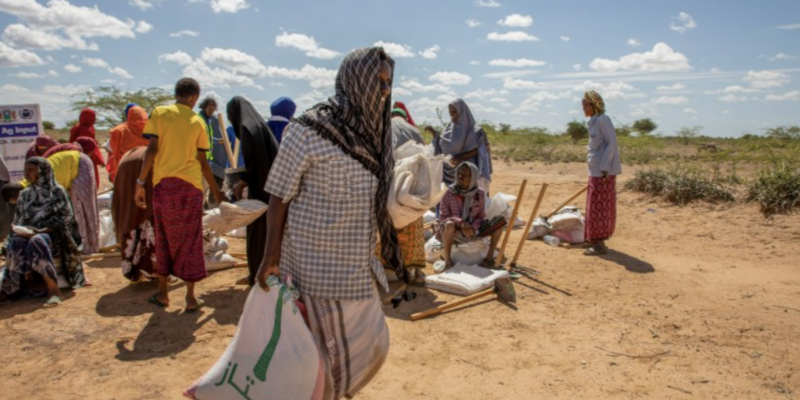Climate change is a major driving force propelling people into migration. Somalia is among the most affected countries. Not only is it plagued by internal conflicts, but it is also particularly affected by environmental disasters ranging from floods to droughts, which increase food insecurity and therefore pressure to take more drastic decisions toward survival. A study conducted by Rahman Momeni, Tuba Bircan and Robert King under the HummingBird project analysed the factors that contribute to Somalia’s climate mobility. Oiza Q. Obasuyi is going to tell us more about it.
Wars and persecution are not the only driving factors behind migration. Environmental disasters linked to climate change are becoming more and more frequent, leading affected people to seek safety and security elsewhere. In this regard, researchers Rahman Momeni, Tuba Bircan and Robert King published a research paper entitled Environment-induced internal displacement. The case of Somalia. The paper takes a specific focus on Somalia and the characteristics of a high migration country as a result of climate change.
Somalia’s instability, the researchers explain, is fuelled by ongoing conflicts, long-lasting epidemic outbreaks, weak social protection systems, unstable climatic conditions, and additional issues that contribute to the deterioration of agriculture and livestock activities down to pastoral and rural livelihoods, which means food security. “According to the World Bank, Somalia is one of the poorest countries in the world, as nearly 70 per cent of the population lives below the poverty threshold, earning less than $2 a day,” the researchers report. This contributes to a protracted humanitarian crisis marked primarily by internal displacements: in fact, this country is experiencing extreme weather events, i.e. cases in which weather conditions cause considerable internal damage.
“If you look at the history of Somalia, droughts and floods have been the main extreme weather events that occur persistently. Constant periods of drought alternating with flood events cause soil degradation […]” thus posing a serious danger to crops. For example, the report says, “the most extreme drought in Somalia in the last decade occurred in 2011, when nearly 258,000 people lost their lives. Thereafter famine struck Bay, Bakool, and other regions of Lower and Middle Shebelle, located in central and southern Somalia […].” Another case of drought, which began in 2015 and peaked in late 2016 and early 2017, is also reported in the research. On this occasion, more than 800,000 Somali people fled their homes in search of water and sustenance. Moreover, in 2018, Somalia was the most affected African country, with 167,000 people displaced between the months of January and June due to drought. The research states that, according to UNHCR data, more than three million Somali people have been forced to flee due to frequent droughts and floods since 2016. “In areas such as Somalia,” the researchers write, “that are prone to multiple or recurring extreme weather events, environmental conditions can lead to repeated displacement, contributing to increased vulnerability of people”.
With climate change and the increasing frequency of environmental disasters, people living in the most deprived areas are more vulnerable both socially and economically. These factors force people to leave their homes: migration, whether voluntary or forced, international or internal, besides being a human right, is a direct consequence of an environment that is becoming more and more unlivable. In the case of Somalia, the researchers highlighted some aspects relating to how people respond to environmental disasters. Firstly, the researchers explain that when floods or inundations occur, people begin to leave shortly before the onset, tending to return to their homes soon afterwards. Drought, on the other hand, “is more progressive, and adaptation to this change is more challenging. People begin to leave their homes with a delay from the start of the climatic event and the number of internally displaced persons gradually increases. Returning to their homes also takes much longer in this case.”
According to a new scientific article in the journal Frontiers Climate migration research and policy connections: progress since the Foresight Report, more and more academics are switching from the term ‘climate mobility’ to ‘climate migration’. Research on human mobility in the context of climate change recognises the multiple ways in which people move: in fact, talking about mobility “points out that human mobility should not be studied as something exceptional, rather, as something normal in a highly interconnected world, and therefore research on climate mobility should focus on the role of climate hazards in affecting existing mobility patterns”.
Putting back at the centre the right to freedom of movement, which is now being hindered by the so called ‘Fortress Europe’ due to increasingly restrictive policies based on systematic rejections, is still a key issue, especially in a context where climate change is turbulent and squeezing people out from unstable places. The lack of climate action on the part of the most powerful countries’ governments needs to be replaced by policies aimed at stopping the collapse of the planet, as the Ipcc highlighted in its latest report.
This study was produced as part of Humming Bird. Humming Bird is a Horizon 2020 project that aims to improve the mapping and understanding of changing migration flows.
Cover photo via Twitter/FAO Emergencies









